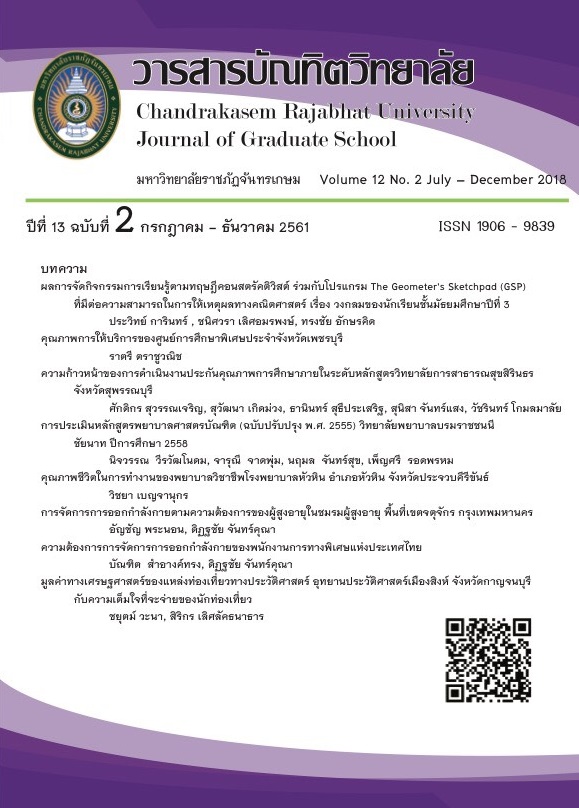ความต้องการการจัดการการออกกำลังกายของพนักงานการทางพิเศษ แห่งประเทศไทย
Main Article Content
บทคัดย่อ
การวิจัยนี้มีวัตถุประสงค์ เพื่อ (1) ศึกษาความต้องการการจัดการการออกกำลังกายของพนักงานการทางพิเศษแห่งประเทศไทยในด้านสถานที่ อุปกรณ์ และสิ่งอำนวยความสะดวก ด้านกลุ่มของกิจกรรมการออกกำลังกาย ด้านการจัดการ และด้านบุคลากรที่ให้บริการ (2) เปรียบเทียบความต้องการการจัดการการออกกำลังกายของพนักงานการทางพิเศษแห่งประเทศไทย โดยจำแนกตามเพศ อายุและฝ่าย การวิจัยนี้เป็นการวิจัยเชิงปริมาณ ดำเนินการเก็บข้อมูลกับพนักงานการทางพิเศษแห่งประเทศไทย จำนวน 365 คน เครื่องมือที่ใช้ในการวิจัย คือ แบบสอบถามแบบมาตราส่วนประมาณค่า 5 ระดับ สถิติที่ใช้ในการวิจัย คือ ค่าร้อยละ ค่าเฉลี่ย ค่าเบี่ยงเบนมาตรฐาน การทดสอบค่าที การวิเคราะห์ความแปรปรวนทางเดียว ในกรณีที่พบความแตกต่างอย่างมีนัยสำคัญทางสถิติจะใช้การทดสอบรายคู่ด้วย LSD (Least Significant Difference)
ผลการวิจัยพบว่า (1) พนักงานการทางพิเศษแห่งประเทศไทยมีความต้องการการจัดการการออกกำลังกาย โดยรวมอยู่ในระดับมาก และเมื่อพิจารณาเป็นรายด้านพบว่า ด้านสถานที่ อุปกรณ์ และสิ่งอำนวยความสะดวก ด้านกลุ่มของกิจกรรมการออกกำลังกาย ด้านบุคลากรที่ให้บริการ พนักงานมีความต้องการการจัดการการออกกำลังกายอยู่ในระดับมาก และด้านการจัดการ พนักงานมีความต้องการอยู่ในระดับปานกลาง (2) พนักงานการทางพิเศษแห่งประเทศไทยที่มีเพศ อายุ และฝ่ายต่างกันมีความต้องการการจัดการการออกกำลังกาย โดยรวมแตกต่างกัน
สรุปผลการวิจัยพบว่า ความต้องการการจัดการการออกกำลังกายของพนักงานการทางพิเศษแห่งประเทศไทยให้ความสำคัญกับด้านสถานที่ อุปกรณ์ และสิ่งอำนวยความสะดวก มากที่สุด เพศหญิงและเพศชาย และพนักงานที่มีฝ่ายต่างกันมีความต้องการการจัดการการออกกำลังกายที่แตกต่างกัน โดยมีข้อเสนอแนะว่าการทางพิเศษแห่งประเทศไทยควรมีศูนย์ออกกำลังกายสำหรับพนักงานที่อำนวยความสะดวกเรื่องสถานที่ อุปกรณ์ รวมทั้งการให้
บริการด้านการออกกำลังกายเพื่อพัฒนาคุณภาพชีวิตที่ดีของพนักงานและเพิ่มประสิทธิภาพในการทำงาน
Article Details
เอกสารอ้างอิง
2. กาญจนศรี สิงห์ภู่. (2555). การออกกำลังกายเพื่อสุขภาพของประชาชน. สืบค้น 23 ตุลาคม 2560, จาก http://www.srinagarindhph.kku.ac.th/index.php?option=com_content&view=article&i d=86:2011-11-09-06-40-59&catid=44:2011-06-13-02-42-42&Itemid=63
3. กุศล บุญสบ. (2551). สภาพและความต้องการการออกกําลังกายของผู้ออกกําลังกายในอําเภอเกาะยาว จังหวัดพังงา กรุงเทพฯ: มหาวิทยาลัยศรีนครินทรวิโรฒ.
4. ธวัชชัย สุกใส. (2550). ความต้องการการออกกำลังกายของประชาชนในเขตอำเภอเขาย้อยจังหวัด เพชรบุรี. กรุงเทพฯ: มหาวิทยาลัยเกษตรศาสตร์.
5. นงลักษณ์ ใจฉลาด. (2551). ศึกษาสภาพและความคิดเห็นต่อการออกกำลังกายและเล่นกีฬาของนิสิตมหาวิทยาลัยนเรศวร ประจำปีการศึกษา 2551. พิษณุโลก: มหาวิทยาลัยนเรศวร.
6. ประวิทย์ สุทธิบุญ. (2550). ความต้องการการออกกำ ลังกายของประชาชนในสวนสาธารณะของเขต เทศบาลนครอุดรธานี. กรุงเทพฯ: มหาวิทยาลัยศรีนครินทรวิโรฒ.
7. ประเวศ วะสี. (2551). สุขภาวะที่สมบูรณ. กรุงเทพฯ: หมอชาวบ้าน.
8. พวงรัตน์ ทวีรัตน์. (2540). วิธีการวิจัยทางพฤติกรรมศาสตร์และสังคมศาสตร์. กรุงเทพฯ: สำนักทดสอบทางการศึกษาจิตวิทยา มหาวิทยาลัยศรีนครินทรวิโรฒประสานมิตร.
9. เพ็ญแข คุณาเจริญและกรองทอง ชวลิตธำรง. (2551). พจนานุกรมไทยวัฒนาพานิช อังกฤษ-ไทย. กรุงเทพฯ: ไทยวัฒนาพานิช.
10. เรืองศักดิ์ ศิริผล. (2542). การออกกำลังกายกับการควบคุมโรคความดันโลหิตสูงโรคเบาหวาน โรคหัวใจขาดเลือด. กรุงเทพฯ: ชุมชนสหกรณ์การเกษตรแห่งประเทศไทย.
11. Schiffman, Leon G. and Kanuk Leslie Lazar . (1991). Consumer Behavior. (4th. ed.). New Jersey: Englewood Cliffs.
12. อรษา คชสีห์. (2550). ความต้องการออกกำลังกายของนักศึกษามหาวิทยาลัยเทคโนโลยีราชมงคล (วิทยานิพนธ์ ศึกษาศาสตร์มหาบัณฑิต). กรุงเทพฯ: มหาวิทยาลัยรามคำแหง.


